The Bridge Street Bridge
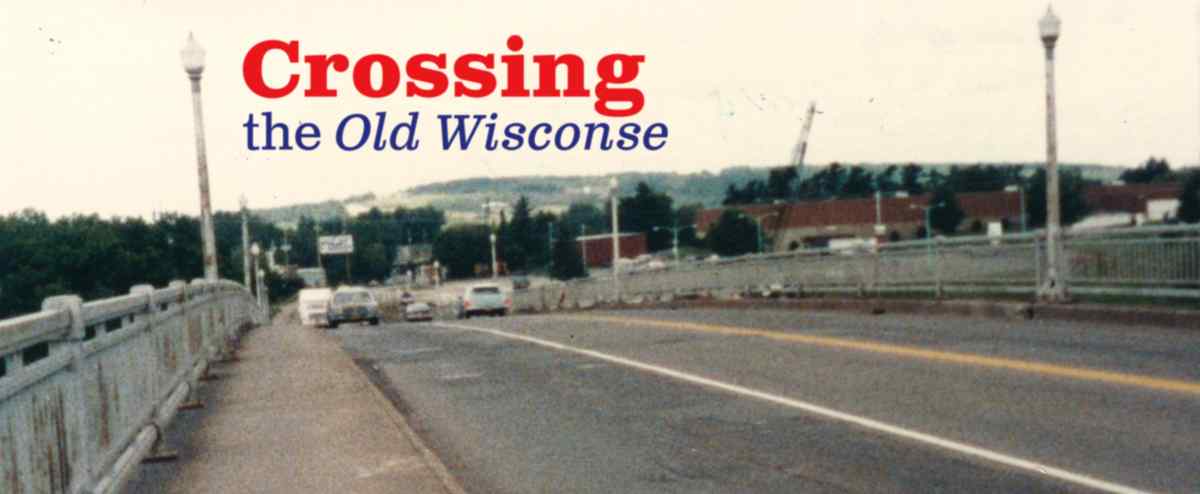
The name Bridge Street, while perhaps a bit plain, is certainly an appropriate moniker for the thoroughfare on Wausau’s north end. There has been a bridge at this location since at least 1883 and it has had one of the most varied and at times chaotic histories of any crossing in the city.
In 1882, Messrs. M.P. Beebe and J.E. Leahy established a mill on the west side of the Wisconsin River at approximately the location of modern-day Bridge Street. At about the same time, Mr. J.C. Smith was operating a planing mill directly across the river. Though these locations may have been advantageous for mills they were also nearly a mile north of the nearest river crossing. Indeed, those on the north end of Wausau would have faced quite the trek to the Falls Bridge whenever they needed to cross the river. As the town continued to spread north it became imperative that another means of crossing the river be provided.
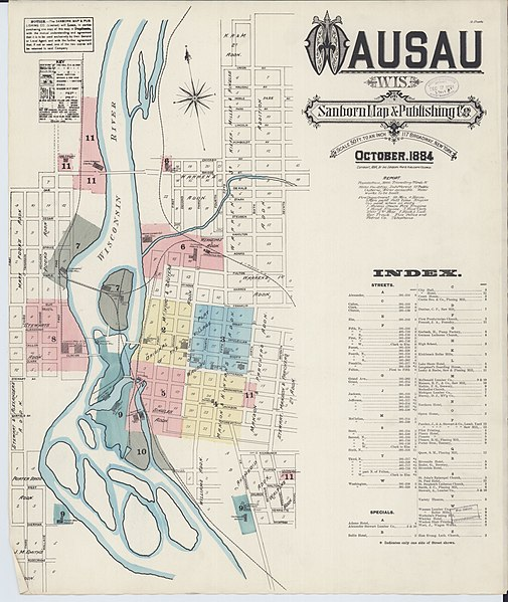
Very few if any photos exist of the early Bridge Street Bridge but this 1884 Sanborn Map
clearly shows the newly completed bridge on the extreme north end of town.
Credit: Library of Congress
Off to a Shaky Start
In 1883, a bridge was constructed at Bridge Street. Named the Leahy Beebe Bridge after the mill it was, in part, built to serve, a name which it and its successors would carry well into the 1940s. This bridge does not appear to have been very well documented.1 It was likely of the covered type and although it was described as permanent it only stood for 14 years. In 1897, the original Bridge Street Bridge was unceremoniously replaced by A. A. Lamphier & Co. with a new more modern piling bridge.2 The piling design, although certainly more modern than a covered bridge, proved to be a poor choice. The numerous pilings supporting the structure proved a hindrance to the yearly log drives and the impacts of logs against them began to take a toll on the bridge’s structural integrity. To alleviate this problem a draw, or moveable, span was retrofitted to the bridge; the idea being that logs could be herded through it instead of being allowed to pile up against the bridge supports.3 Ironically, the very modification meant to save the bridge from destruction actually led to its loss. The draw section had not been constructed properly and, while it had never been totally satisfactory, by 1909, it was positively dangerous.4 In the end the “modern and permanent” bridge only lasted twelve years to its predecessor’s fourteen.
Wausau's Bad Luck Bridge
Up until this point, Wausau’s bridges were generally quickly built affairs constructed of locally sourced timbers. The 1909 bridge would be different. In August of 1909,5 a huge order of Douglas fir and Tamarack6 was to be shipped from Washington State. These trees were extremely rot-resistant and, it was believed, would lend themselves well to constructing a sturdy, long-lasting, bridge. The city was told the timber would arrive within ten days7 and as such the old bridge could come down with little inconvenience to its citizens. With this in mind, the demolition of the old bridge began with the belief that the new one would be completed within a month. Ten days passed, then ten weeks. Though a few pieces of the bridge had arrived and been set in place, the majority of the major structural components had simply vanished in transit.8 With no bridge to cross, people living on the north end of Wausau were forced to detour to the Falls Bridge or else risk crossing the boom chains just as their ancestors had done some seventy years prior. By November of 1909, there were still two carloads of timber that had yet to arrive and it was finally decided that the bridge would open the next month, finished or not.9 After being open to traffic for more than a month in what spme clamed to be a dangerously unfinished state, the bridge was finally completed in January 1910. The structural timbers that were supposed to have been shipped in just ten days had taken six months, only arriving after representatives of the city and bridge contractor had physically gone to track them down.10
The bridge’s luck continued to falter from there. In 1912 the barely three year old bridge was almost entirely washed away during the infamous flood that all but destroyed Wausau.11 In 1920, ice flows would shove its replacement off of its foundation and carry away part of its deck necessitating major repairs.12 By the 1920s the Bridge Street Bridge was a cobbled together mess consisting of portions of the 1909 bridge as well as 1912 and 1920 repairs neither of which had been meant to be permanent. It was also far too narrow. Having been built for wagon and foot traffic the bridge was barely wide enough to accommodate two lanes of auto traffic.13 The situation was made wrose by the fact that there were over 123 auto and truck crossings an hour with loads spiking to 258 crossings during rush hour.14 This was simply too much to ask of an almost 20-year-old wooden bridge. The situation became more complicated as local businesses began to complain of delays caused by traffic jams.15 In an attempt to relieve some of the strain on the old bridge, the city rerouted its fledgling bus system over the Falls Bridge eliminating several services to the north end of town in the process. Instead of solving the problem created an additional uproar among north-siders who, already without trolley service, suddenly found themselves without bus service either. Finally, it became clear to all that there was no easy fix.
Just two or three spans of the 1909 bridge survived the 1912 flood.
Credit: MCHS Photo Collection
Steel Beats Timber
Despite the worsening financial conditions brought on by the onset of the Great Depression, funding was finally authorized in November of 1930 to the tune of $270,000 split between city, county, and state.16 The ’09 bridge was officially closed to all traffic on November 18, 1931, and construction began on what the local papers had branded as “Wausau’s Super Bridge."17The new Bridge Street Bridge was one of several of so-called “Super Bridges” erected during a flurry of bridge building in the county. Others included the Rib River crossing at Marathon City, the Eau Claire River Bridge at Schofield, and the McCleary or “Snake” Bridge at Fleith (Rib Mountain.) All of these bridges were of a thoroughly modern steel and concrete construction and, it was claimed, would add immensely to the beauty and safety of the roads they served.
With the country in the grips of the Great Depression all control of hiring for construction crews was handed over to the unemployment commission.18 Some 300 unemployed men applied to work on the bridge. Those accepted were organized into two shifts of six hours each and could expect to earn anywhere between $0.40 and $1.25 an hour.19 The new bridge included major improvements over its predecessor. It was a concrete and steel deck truss structure as opposed to wooden through truss. At 36 feet wide it was more than wide enough to accommodate two lanes of traffic and a dedicated pedestrian walk on its southern side. Finally, its eastern approach was constructed in such a way that it passed over the Milwaukee Road tracks, eliminating what had been a particularly hazardous and even deadly grade crossing.20 After a little less than a year of construction the new Bridge Street Bridge would open to traffic in October of 1932.21
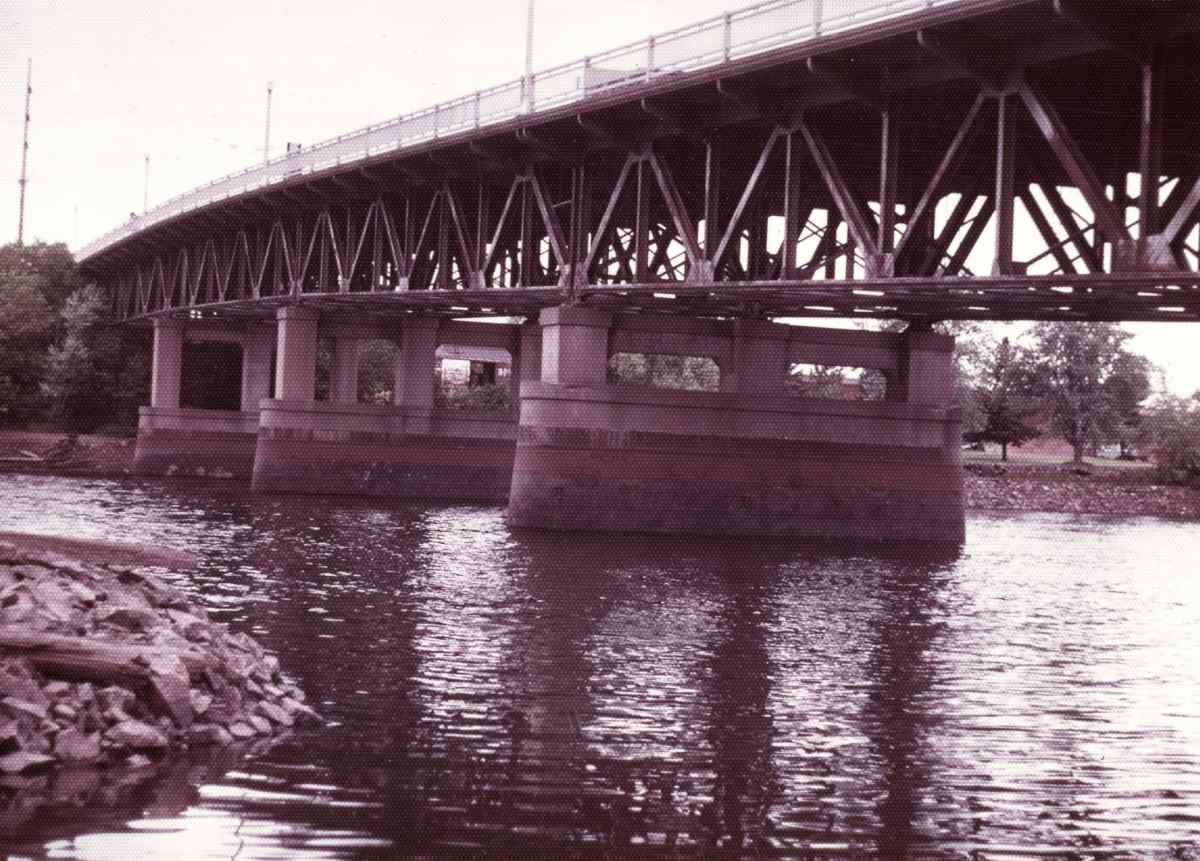
The 1932 bridge pictured towards the end of its life.
Credit: MCHS Photo Collection
A Modern Bridge for a Modern Bridge Street
The 1932 bridge performed its job admirably for many decades. Even in the 21st century the average lifespan of a road bridge is 44 years yet the 1932 Bridge Street Bridge stood until 1986, an impressive 54 year lifespan. In the end a number of factors led to its replacement. By the 80s, the bridge had far outlived its projected useful life and the years of constant heavy traffic were beginning to take their toll. People began to report pieces of concrete dropping off of the bottom of the road deck, cracks were noted throughout the structure, and in places rusting rebar was visible protruding from the bridge. Inspections showed that, despite the alarming appearance, the bridge was actually remarkably structurally sound though it would need at least a new road deck if it were to continue serving the community.22 The bigger problem by far was the number of traffic accidents attributed to the bridge. Unlike the current bridge which lies perpendicular to the river channel the 1932 bridge crossed at an angle necessitating a sharp curve in the road at either end. This combined with a narrow two-lane road deck proved extremely hazardous and on several occasions, cars ended up in the river after having failed to make the abrupt corner or otherwise having been crowded out by other traffic.23-27The final blow came when it was determined that a replacement road deck would cost approximately as much as an entire new bridge.28 Once a new bridge was decided upon it also became clear that a major street widening project would be necessary as well. The new bridge and its approaches would be four lanes, two in each direction, and it was hoped that this would eliminate the traffic problems and hopefully prevent future accidents.
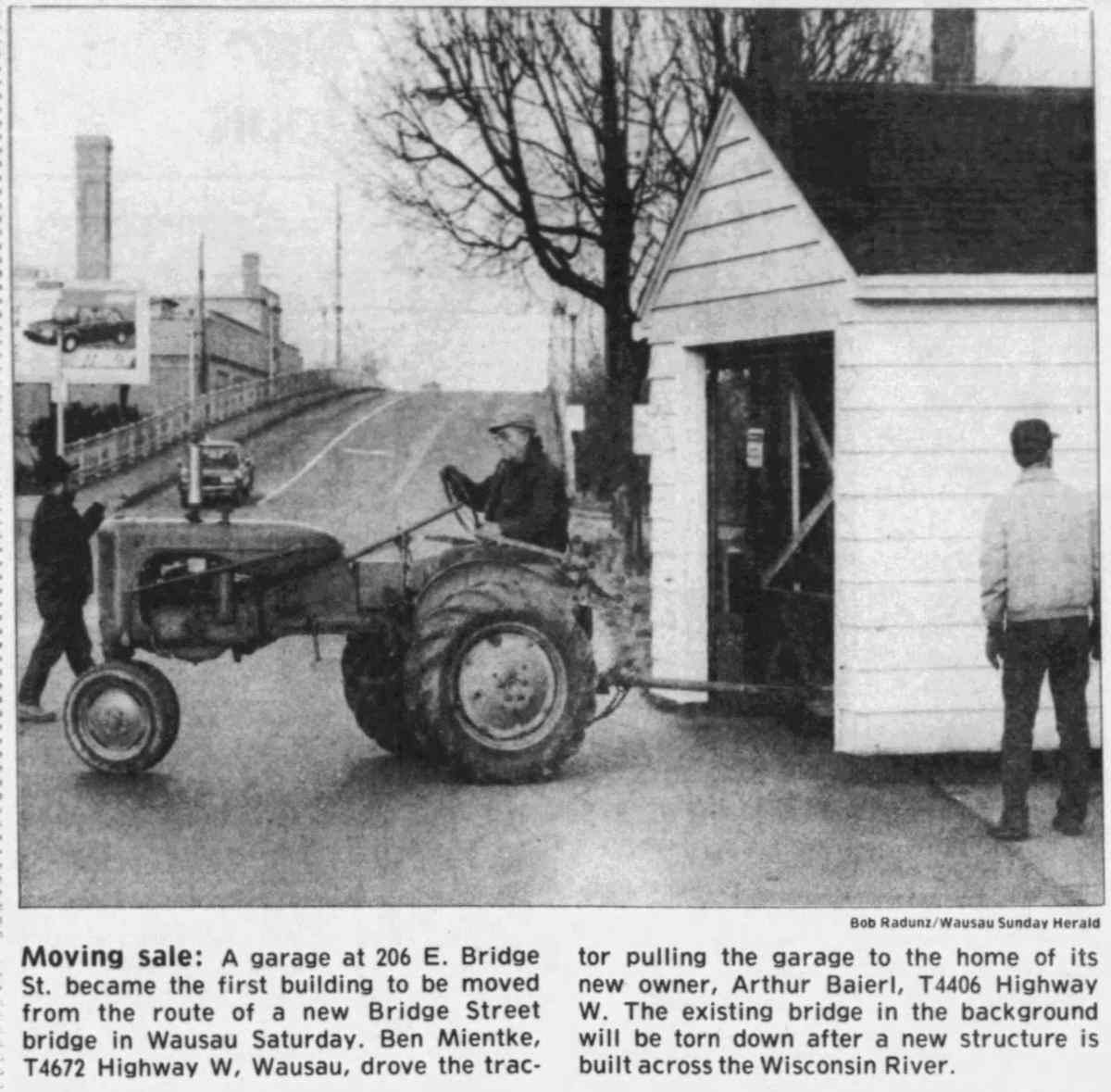
Credit: Wausau Daily Herald 1986
Construction of the current bridge began rather strangely with the moving of a garage. The little structure, towed away down the street by a tractor,29 would be the first of nearly a dozen properties moved or demolished in preparation for the widened Bridge Street Bridge.30 Ironically, among the buildings demolished to make way for the new bridge were the offices of the Mortenson & Stone Lumber Company,31 successor to the Leahy & Beebe Lumber Co. which the bridge was built to serve. Unlike previous projects, the 1932 bridge was not closed and demolished before construction began on its successor. The old Bridge Street Bridge was left standing and in use while the new bridge went up alongside it. The current bridge opened to traffic in July, 1987 and the 1932 bridge finally came down shortly afterwards. According to the designers the current bridge should continue to serve the community for at least another forty years making it set to be the longest lasting Bridge Street Bridge so far.32
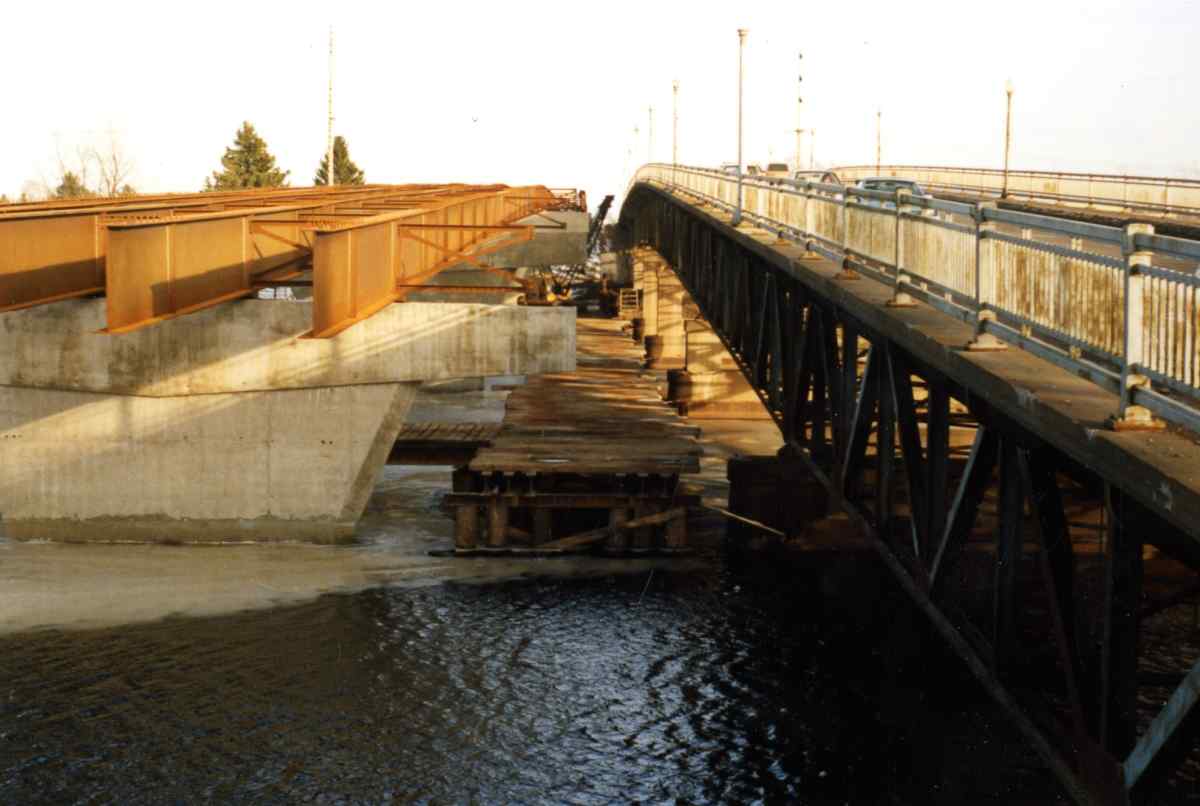
The current bridge goes up next to its predecessor, which would remain standing and open to traffic until the new bridge was completed.
Credit: MCHS Photo Collection
The newly completed Bridge Street Bridge
Credit: MCHS Photo Collection
< Previous Story Glossary Main Index Next Story >
